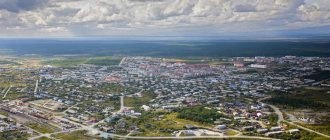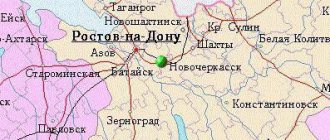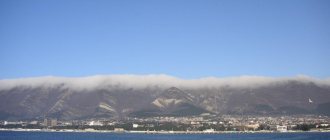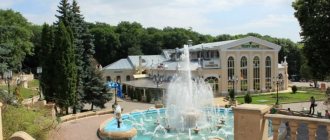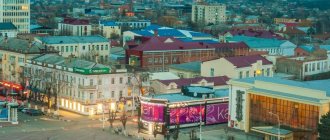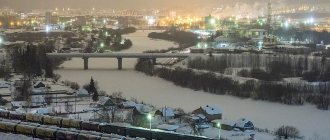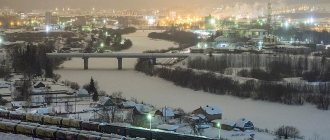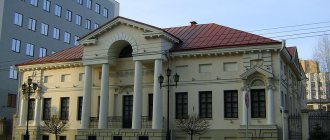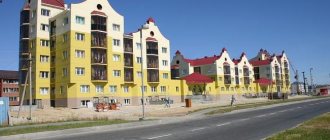Chronicles
Where is Tarko-Sale? In 1933, construction of a settlement began on the banks of the Pur River. At the same time, a small first-aid post with five beds was opened.
In 1934, a decision was made to create an inspectorate under the Purovsky District Executive Committee for the purpose of carrying out national economic accounting. In addition, the Rybkoopsoyuz was organized. One of the most important events was the organization of a regional radio communication center, after which radio points appeared in homes.
In 1935, the Department of Public Education was formed in the Purovsky district. There were seventeen students in the local school. Subsequently, the map of Tarko-Sale was replenished with a registry office, a people's court, a hospital, a fishing and reindeer herding collective farm, a veterinary station, a canteen, and a boarding school.
“Made with us” and on Yandex.Zen
Tarko-Sale is the youngest and at the same time one of the oldest cities in Yamal.
https://fotki.yandex.ru/users/lapshin-8975/view/505351/
The history of the city began on January 7, 1932, when by decree of the All-Russian Central Executive Committee the Purovsky district was formed as part of the Yamal (Nenets) national district with a temporary administrative center in the middle the flow of the Pur River. In those distant years, the middle course of the river was the most uninhabited part of the future region; the natural border of settlement of the tundra and forest Nenets passed there. In April of the same year, the so-called Purov expedition was formed, headed by the chairman of the organizing bureau for organizing the region, Georgy Ivanovich Onosov. The members of the expedition were faced with the following tasks: to get to the river before the beginning of the spring thaw. Pur and in the summer to complete the work on organizing the Purovsky district. But due to early spring, the expedition was postponed until navigation opened. And only at the beginning of September 1932, on a barge towed by the Anastas Mikoyan motor ship, the expedition reached the village of Khalmer-Sede (now Tazovsky). The further journey, already along the Pur River, was continued on a barge, which was towed by a boat from the Uralpushnina enterprise. Due to ignorance of the river's fairway, the caravan moved slowly and only during daylight hours. Winter found the district organizers in the area of the future Urengoy settlement. There, on the left bank of the river, the expedition members stopped for the winter. Subsequently, the trading post, and then the village of Urengoy, were built on the right, higher and more convenient bank.
Administration of the Purovsky district.
“Administration of the Purovsky district of Tarko-Sale” on Yandex.Photos
https://fotki.yandex.ru/users/lapshin-8975/view/505347/“Administration of the Purovsky District.”
on Yandex.Photos Fire station.
"Fire Department."
on Yandex.Photos Memorial complex.
"Memorial Complex."
on Yandex.Photos At the end of December 1932, part of the expedition on reindeer sleds continued its journey up the river and a few days later reached the confluence of the Pyaku-Pur and Aivasedo-Pur rivers. After examining the area, the right bank of the Pyaku-Pura was recognized as the highest and most convenient place for the construction of the future regional center. On one of the trees that grew here, Mikhail Sargin, a member of the organizing bureau for organizing the district, made a note and wrote “Build here.” At this legendary place there now stands the monument “Coming from the Horizon”. The name of the future regional center was suggested by the Nenets: “Talka salya” means “settlement at the confluence of rivers.”
Bank of Tarko-Sale.
“Bank of Tarko-Sale” on Yandex.Photos
“Coming from the horizon.”
"They came from the horizon." on Yandex.Photos
https://fotki.yandex.ru/users/lapshin-8975/view/510443/
Tax Inspectorate.
“Our Tax Inspectorate” on Yandex.Photos
ST. NICHOLAS TEMPLE
https://fotki.yandex.ru/users/lapshin-8975/view/510442/
"ST. NICHOL'S TEMPLE" on Yandex.Photos
"In festive decorations." on Yandex.Photos
“St. Nicholas Church. Tarko-Sale, Yamalo-Nenets Autonomous Okrug" on Yandex.Photos
https://fotki.yandex.ru/users/lapshin-8975/view/505349/
The wintering experience of 1933 convinced the expedition members that the future regional center should be located as close as possible to the place of compact residence of the indigenous people. In those years, only a few families of Forest Nenets lived in the Urengoy area, and two clans roamed in the immediate vicinity of Tarko-Sale - Pyak and Aivasedo. On May 7, 1933, at the fourth meeting of the organizing bureau, the final decision was made to begin the development of a new settlement at the confluence of the Pyaku-Pur and Aivasedo-Pur rivers. At the beginning of August 1933, the organizing bureau for organizing the region left the Urengoy winter quarters. And on August 6, 1933, the first meeting of the Purovsky District Executive Committee took place in Tarko-Sale, at which it was decided to quickly begin the construction of a trading post, houses to accommodate people and premises for the Purovsky District Executive Committee. It was planned to complete construction of the first house by September 5.
Technical supervision service of the Yamal-Nenets Autonomous Okrug.
"Technical Supervision Service of the Yamal-Nenets Autonomous Okrug."
on Yandex.Photos KSK "Geologist".
"KSK "Geologist."
on Yandex.Photos Office of NOVATEK - Tarkosaleneftegaz LLC.
"Office of NOVATEK - Tarkosaleneftegaz LLC."
on Yandex.Photos Tarkosali Second School.
“Tarkosalinskaya school is the second.”
on Yandex.Photos It should be noted that right up to the beginning of the Great Patriotic War, the issue of moving the regional center from Tarko-Sale to another, more convenient place was repeatedly raised. Of all the options, two were the most discussed. The first is the Kharampur trading post, where in those years the density of the indigenous population was the highest in the region. And the second is the Kamennaya Gora tract, located from Tarko-Sale forty kilometers downstream of the Pura. The advantage of this place was its safety during the spring flood. Preparatory construction work even began here, and the first construction site established in the Purovsky district was called Kamennaya Gora. But these plans were not destined to come true; the war interfered.
Winter is coming soon.
"Winter is coming soon."
on Yandex.Photos of the Baikal shopping center.
"etc.
BAIKAL" on Yandex.Photos of the MEGA shopping center
"SPRING CAME.
04/18/2010.” on Yandex.Photos Pharmacy management and pharmacy.
“Pharmacy management and pharmacy” on Yandex.Photos
City administration.
"City Administration."
on Yandex.Photos The administrative center of Tarko-Sale, in contrast to the cities formed in the region during the “oil boom” of the 60-80s (Noyabrsk, Muravlenko, Gubkinsky), changed slightly. From its foundation, the village developed chaotically, without centralized networks. All buildings were built in wood, as temporary ones.
Pension fund building.
"Pension fund building." on Yandex.Photos
"Fountain." on Yandex.Photos
"My house." on Yandex.Photos
“Fountain” on Yandex.Photos
In the fall of 1933, the problem of providing the population with food arose. In this regard, the question arose about the formation of a collective farm, which could allow planned and stable production of products in the conditions of the unpredictable northern nature. For many years, it was agriculture that served as the economic basis for the life of the village and the region as a whole, and the enterprises that were the “progenitors” of the Verkhne-Purovsky agricultural enterprise arose simultaneously with the settlement - these are fishing artels. Therefore, the history of Tarko-Sale is almost unthinkable without the history of this enterprise. The history of the Verkhne-Purovsky agricultural production complex began in 1935, when the Muzhevsky deer farm was formed in the Shuryshkarsky district, which in the 40s was transferred to the Purovsky district. Based on the decision of the Yamalo-Nenets regional executive committee, on January 1, 1945, the Verkhne-Purovsky state farm was formed. M.N. was appointed the first director of the state farm. Kolitupkov. In parallel, on the territory of the Purovsky district, two collective farms were formed from traveling trading posts and simple production partnerships: in 1937 - the collective farm named after. March 8, and in 1943 - the collective farm named after. Stalin, which were annexed to the state farm in 1961, forming a single reindeer herding state farm “Verkhne-Purovsky”.
"City autumn." on Yandex.Photos
https://fotki.yandex.ru/users/lapshin-8975/view/505348/
https://fotki.yandex.ru/users/lapshin-8975/view/505350/
https://fotki.yandex.ru/users/lapshin-8975/view/505726/
In the 60-80s. XX century Tarko-Sale becomes one of the two industrial centers of the region (the second is the village of Urengoy). This time can be called a period of rapid transition from a weak agricultural economy to the development of large industrial production. Geophysicists were the first to come to the Purov land. In the summer of 1961, a detachment of the Tazov seismic exploration party under the leadership of M.S. Sharafutdinova carried out river seismic survey work along the Pur River from the village. Samburg to the upper reaches of the Pyaku-Pur River. After the end of the summer field season, the detachment was left for the winter in Tarko-Sale, where an independent seismic exploration team was created on its basis. In 1964, the drilling site was relocated to Tarko-Sale from the Narykar oil exploration expedition under the leadership of drilling master Viktor Ivanovich Shestakov. On January 13, 1965, on the banks of the Pyaku-Pur River, on Purpeyskaya Square, a drilling team led by Viktor Ivanovich began drilling the first deep well in the Purovsky region. To further explore the territory of the region, on April 1, 1965, the Tarkosali oil exploration expedition was created, thanks to whose work such large fields as Komsomolskoye, Tarasovskoye, East-Tarkosalinskoye, and West-Tarkosalinskoye were subsequently discovered. It was during this period that Tarko-Sale began to develop as an industrial center. New fields are being discovered, a gas pipeline and the Surgut-Urengoy railway are being built.
https://fotki.yandex.ru/users/lapshin-8975/view/510429/
https://fotki.yandex.ru/users/lapshin-8975/view/510430/
The city-forming industry is oil and gas production. Main enterprises: NOVATEK-PUROVSKY ZPK - the largest gas condensate processing plant in Russia; NOVATEK-Tarkosaleneftegaz is an oil and gas producing company.
Sargin embankment.
https://fotki.yandex.ru/users/lapshin-8975/view/510431/https://fotki.yandex.ru/users/lapshin-8975/view/510432/
In 1976, Tarko-Sale began to belong to the category workers' villages. In 1977, it was gasified. The development of the oil and gas industry contributed to the favorable development of the village and an increase in population. In 1967, after the death of the great drilling master Andrei Fedorovich Tarasov, the Tarasovskoye field and one of the central streets of the city of Tarko-Sale were named after him.
https://fotki.yandex.ru/users/lapshin-8975/view/510433/
Cultural center.
https://fotki.yandex.ru/users/lapshin-8975/view/510434/
In 2004, Tarko-Sale was given the status of a city. This was largely facilitated by the changes and improvements that took place in the late 90s; now more than 20 thousand people live in the city. In 2013, Tarko-Sale will celebrate its 80th anniversary.
https://fotki.yandex.ru/users/lapshin-8975/view/510435/
https://fotki.yandex.ru/users/lapshin-8975/view/510436/
https://fotki.yandex.ru/users/lapshin-8975/view/510437/
GeoPur Hotel.
https://fotki.yandex.ru/users/lapshin-8975/view/510438/
https://fotki.yandex.ru/users/lapshin-8975/view/510439/
Square near Tarkosaleneftegaz.
https://fotki.yandex.ru/users/lapshin-8975/view/510440/https://fotki.yandex.ru/users/lapshin-8975/view/510441/https://fotki.yandex.ru/ users/lapshin-8975/view/510444/
https://fotki.yandex.ru/users/lapshin-8975/view/510445/
Old House of Culture.
https://fotki.yandex.ru/users/lapshin-8975/view/510446/
Military registration and enlistment office.
https://fotki.yandex.ru/users/lapshin-8975/view/510447/
School.
https://fotki.yandex.ru/users/lapshin-8975/view/510448/
https://fotki.yandex.ru/users/lapshin-8975/view/510449/
Kindergarten.
https://fotki.yandex.ru/users/lapshin-8975/view/510450/
https://fotki.yandex.ru/users/lapshin-8975/view/510451/
https://fotki.yandex.ru/users/lapshin-8975/view/510452/
https://fotki.yandex.ru/users/lapshin-8975/view/510455/
https://fotki.yandex.ru/users/lapshin-8975/view/510456/https://fotki.yandex.ru/users/lapshin-8975/view/510457/
https://fotki.yandex.ru/users/lapshin-8975/view/510458/https://fotki.yandex.ru/users/lapshin-8975/view/510459/
Post-war period
In 1947, many learned about where Tarko-Sale was located, since a unique estate of the Verkhne-Purovsky reindeer herding state farm was organized on its territory. It is still popular among travelers exploring the vast expanses of the Russian Federation.
In 1948, construction of the Salekhard-Igarka railway section began. The builders were fully provided with food and materials by local enterprises. A little later, the district authorities carried out certification of the village population and formed five streets. All households were assigned numbers.
Hard times
In general, the fifties of the twentieth century were a difficult period in the formation of the city. The development of Tarko-Sale, and the whole country, in principle, at that time proceeded at a depressingly slow pace. The forces of Soviet citizens, including Purovites, were aimed at restoring the national economy as quickly as possible after the devastating hostilities. However, although life after World War II could not be called easy, there were still some positive moments in the history of the city. So, it was during this period that the authorities of Tarko-Sale began to think not only about how to put an extra ruble into the country’s piggy bank, but also how to improve the life of the local population and organize their leisure time. One of the most significant in this regard was the formation of the Purovsky District Industrial Plant, the functioning of which was aimed at meeting the urgent needs of the Tarkosalan residents. In addition, the district cultural and educational department began its activities. In 1951, a sports community called “Collective Farmer” was created on a voluntary basis.
This is how slowly, literally brick by brick, the social foundation of the city was laid.
Life is getting better
The main event of the 1950s, both on a city and national scale, was the decision to stop the construction of the railway on the Salekhard-Igarka section. At the same time, the “rolling” of thousands of human lives under the “piece of iron” stopped. The unfortunate citizens no longer perished in the vast expanses of the Gulag. The image of Tarko-Sale as a unique zone began to gradually fade in the minds of millions of Soviet citizens.
Honorary statuses
In 1976, Tarko-Sale became a workers' village. The decision to assign this status was made by the executive committee of the regional Council of Deputies of Tyumen. In March 2004, it became a city of regional significance. At the same time, the appearance of Tarko-Sale began to rapidly change for the better. Soon the city acquired its own official symbols - a coat of arms and a flag. The latter is a reflection of the historical, cultural, socio-economic and other local traditions of the municipality.
City `s history
OFFICIAL: Tarko-Sale, as a “temporary administrative center in the area of the middle reaches of the Pur River,” has existed since January 7, 1932, when the Purovsky district was formed by a resolution of the All-Russian Central Executive Committee as part of the Yamal (Nenets) national district. The first documentary mentions of Tarko-Sal came in March 1933. By decree of the Presidium of the Supreme Soviet of the RSFSR dated June 27, 1944, the Tarkosalinsky Village Council of the Purovsky District of the Yamalo-Nenets Autonomous Okrug was formed. On August 18, 1976, by decision of the executive committee of the Tyumen Regional Council of Workers' Deputies No. 418, Tarko-Sale was given the status of a workers' village. The day of formation of the administration of the village of Tarko-Sale is January 8, 1992 - the day of the appointment of the Head of the administration of the village of Tarko-Sale. Based on the Law of the Yamalo-Nenets Autonomous Okrug dated March 30, 2004 No. 16-ZAO, the village of Tarko-Sale of the Purovsky District of the Yamalo-Nenets Autonomous Okrug was classified as a city of regional significance. By the Law of the Yamalo-Nenets Autonomous Okrug of December 20, 2004 No. 113-ZAO “On granting status, determining the administrative center and establishing the boundaries of municipalities of the Purovsky district,” the city of Tarko-Sale, Purovsky district, was given the status of an urban settlement. PHOTO
“80 PAGES OF HISTORY. EVERYTHING IS ONLY AHEAD..." (based on materials from the newspaper "Northern Ray" No. 35 of August 30, 2013) Tarko-Sale is 80 years old.
This, from a historical point of view, is quite a bit. But for the northern latitudes, where we live, the period is quite significant. And surrounded by young cities that were born just a couple of decades ago, Tarko-Sale is a real long-liver. Its fate, like the past of the entire country, is varied. He, along with everyone else, experienced the hardships brought by the Great Patriotic War, he was touched by the dark shadow of the Gulag, experienced all the “charms” of Brezhnev’s “stagnation”, observed the rise and fall of the era of great geological discoveries, went through the imaginary freedom of perestroika and the hopelessness of the early 90s. This is a story that, unfortunately, few people know well... 1933-1942. Place on the map 1933. An organizing team began work on the Pur River to organize the Purovsky district. Elections to the Verkhne-Purovsky village council were held. At the second meeting of the Purovsky organizing team, the procedure for opening a savings bank to regulate money circulation in the Purovsky district was determined, and the issue of other credit functions was also considered. A traveling trading post named after the newspaper “Naryana-Ngerm” (“Red North”) is based in the villages of Ivay-Sale and Tarko-Sale. A first-aid post with five beds was opened in Tarko-Sale. Large-scale construction of the village of Tarko-Sale began. 1934. The Inspectorate of National Economic Accounting was created under the Purovsky District Executive Committee. The work of the Tazov-Purovsky land management expedition began for two regions: Purovsky and Tazovsky. In the village of Tarko-Sale, the Purovsky Fishing Cooperative Society (Purovsky Fishing Cooperative Society of Consumers) was organized. The Purovsky regional communication center was established. The first radio communication antennas appeared. 1935. A broadcast radio center with 75 points was opened. A planning commission for the Purovsky district was organized. Currently, these functions are performed by the Economics Department of the Purovsky District Administration. The Department of Public Education of the Purovsky District was formed. As of August 1, 1935, the school in Tarko-Sale reported: “17 students are studying in one class.
He doesn’t have a building, he works in a small room in RIK’s house .
The civil registry office began working. The village of Tarko-Sale was put on the map of the Tyumen region for the first time. 1936. In order to eliminate illiteracy, the first Red Plague was opened in the Purovsky district, which included: a cultural worker, a medical worker, a veterinary assistant, a teacher and a cinematographer. A district insurance company was organized. A people's court has been created. An outpatient clinic and hospital building with 15 beds was built. 1937. The fishing and reindeer herding collective farm “8 March” was created. The Presidium of the Purovsky District Executive Committee issued a resolution “On measures to combat drunkenness, hooliganism and violation of public order.” 1938. A decision was made to organize a regional veterinary department.
The Tarkosalinsky district hospital began work. Read the entire article:
Economy
Everyone knows how rich Russia is in oil and gas. Tarko-Sale is a city on whose territory the largest plant in the Russian Federation specializing in processing gas condensate and an oil and gas production company are located.
Since 2005, NOVATEK-Purovsky Plant has been processing deethanized gas condensate. This is the first such enterprise in the field of processing natural reserves that has appeared in the post-Soviet space over the past fifteen years. In 2013, the third stage of the plant was launched, and already in January 2014, production capacity was expanded from five to eleven million tons per year. This was achieved thanks to the commissioning of two modern technological lines for stabilizing gas condensate. Their total area is three million tons per year.
In connection with the change in municipal status, by the Decision of the Purovsky District Duma dated September 21, 2022 No. 20, the coat of arms of the Purovsky district was recognized as the coat of arms municipal district Purovsky district. However, the coat of arms has not undergone any changes.
2.1. The heraldic description of the coat of arms of the Purovsky district reads: The coat of arms of the Purovsky district is a blue (blue) shield, against which there is a yellow (golden) stripe with squares located at an upward angle in the color of the field, accompanied by a thin abstract white border, and at the head of the shield - yellow (golden) Arctic fox with a tail shaped like a yellow-white flame. The heraldic “belt” reproduces the national ornament “Deer Path”. The image of a fur-bearing animal represents the combination of the national (traditional) way of economic management with the industrial development of the region. The exact heraldic description of the coat of arms of the region: “In an azure (blue, light blue) field there is a golden belt, burdened with five inscribed rhombuses in the color of the field, having a thin abstract silver border, accompanied at the head by a golden arctic fox, which has a silver tail bordered with gold.”
According to V. Permyakov
The coat of arms of Tarko-Sale was designed by I.A.Morozov (author of the concept), V.V.Startsev and A.K.Grefenshtein. Already in May 2007, the projects received approval from the Heraldic Council under the President of the Russian Federation. The symbols of the city were approved by the Decision of the Meeting of Deputies of the Municipal District of Tarko-Sale dated June 5, 2007 No. 73. By decision of the Meeting of Deputies of the Municipal District of Tarko-Sale dated June 5, 2007 No. 74, the Regulation “On the procedure for the official use of the coat of arms of the municipal formation of the city of Tarko-Sale” was adopted. Description of the coat of arms in the text of the Regulations:
"3.1. Heraldic description of the city's coat of arms: In an azure field dotted with silver ermine tails there is a silver narrow overturned fork-shaped cross, filled with azure at the bottom and accompanied on the sides by two golden (with the same roots) fir trees, and at the end - a sitting squirrel of the same metal. The shield is crowned with a crown established sample. 3.2. Rationale for the symbolism of the city's Coat of Arms: The azure field and silver ermine tails serve as an indication of the northern position of the territory. In addition, the tails themselves that dot the field represent drilling rigs. The fork-shaped cross symbolizes the confluence of two rivers, and also acts as a semi-vocal emblem for the name of the city. Spruces and squirrels serve as signs of natural purity and richness of the subsoil.”
The image used was sent by A.Grefenshtein to the RussoVex conference. Information provided by I.A. Morozov
The coat of arms of Tarko-Sale is included in the State Heraldic Register of the Russian Federation under No. 3352.
Transport system
Where is Tarko-Sale? The city is located three and a half thousand kilometers from Moscow. This route can be covered by car (along the Surgut-Salekhard highway), by train (to the Purovsk railway station) or by plane (the airport is located on the territory of Tarko-Sale).
Currently, direct flights have been established with Novy Urengoy and Salekhard. On September 1, 2013, the grand opening of traffic on the new bridge across the river took place. Pyaku-Pur, connecting Tarko-Sale and Purovsk. The significant structure was erected in record time - in a year and five months instead of the planned three years.
Tarko-Sale
By resolution of the All-Russian Central Executive Committee of January 7, 1932, the Purovsky district was formed as part of the Yamal (Nenets) national district. The temporary center of the newly created administrative unit was located in the area of the middle reaches of the Pur River - today it is the city of Tarko-Sale. In the first half of the 20th century, this area was the most sparsely populated part of the region and was the natural border of settlement of the forest and tundra Nenets. In April 1932, the Purov expedition was organized, headed by the chairman of the organizing bureau for organizing the region, Georgy Ivanovich Onosov. The expedition had to reach the Pur River before the spring thaw in order to complete the work on organizing the Purovsky district. Early spring made its own adjustments, and the expedition had to be postponed until navigation opened. Only almost half a year later, in early September, on a barge that was towed by the Anastas Mikoyan motor ship, members of the expedition were able to reach the village of Halmer-Sede (now the village of Tazovsky in the Tazovsky district). Here the tug was replaced by a boat from the Uralpushnina company, and the expedition continued its journey along the Pur River, stopping for the winter in the area of the future village of Urengoy. By the end of December 1932, part of the expedition, moving on reindeer sleds up the river, reached the confluence of the Pyaku-Pur and Aivasedo-Pur rivers. After examining the area, the right bank of the Pyaku-Pur River was recognized as the most suitable for the construction of the future city of Tarko-Sale. On one of the trees, member of the organizing bureau Mikhail Konstantinovich Sargin wrote the inscription “Build here.” Now at this place there is a monument “Coming from the Horizon”. Later, M. Sargin compiled the first map of the Purovsky district.
Translated from Nenets, Tarko-Sale (“talka salya”) means “cape at a fork.”
In the area of the future city at that time, two clans roamed - Pyak and Aivasedo. It was decided to build a village near the place where the indigenous people lived. On May 7, 1933, at the 4th meeting of the organizing bureau, the final decision on the development of a new village at the confluence of the Pyaku-Pur and Aivasedo-Pur rivers was approved. On August 6, 1933, at the first meeting of the Purovsky District Executive Committee in Tarko-Sale, it was decided to begin construction of the future district center as soon as possible. The first house was supposed to be completed by September 5th. In subsequent years, it was proposed several times to move the center of the district from Tarko-Sale to another place, but the implementation of these plans was prevented by the Great Patriotic War.
In the village under construction there was an acute food problem. Fishing artels were organized here. It was necessary to resolve the issue of forming a collective farm, which was supposed to stably provide the population with food in the harsh conditions of the northern latitudes. In 1935, the Muzhevsky deer farm was organized on the territory of the Shuryshkarsky district, and in the 1940s. the state farm was transferred to the Purovsky district, and on January 1, 1945, the Verkhne-Purovsky state farm was formed. In the late 1930s - early 1940s. In the Purovsky district, a collective farm named after March 8 and a collective farm named after Stalin were founded.
In 1933, an elementary school was opened in the village of Tarko-Sale. It did not have its own separate building and was housed in one room in the RIK house. There was 1st grade at school. In August 1935, 17 students were studying here. The school constantly lacked textbooks, furniture, and firewood. In 1937, a school for adults was opened in the village. In 1939, an elementary boarding school began operating in Tarko-Sale, the first director of which was M. A. Nodel. In 1940, the school was transformed into an incomplete seven-year school.
Since 1932, the “Red Plagues” operated in the Purovsky district, which were the main form of cultural education among the Nenets population. They were mobile propaganda institutions, equipped with medicines and libraries. Employees of the “Red Plagues” explained the policies of the Soviet government, gave lectures on the international situation, collected local folklore, and also recruited children into schools. In addition, they provided medical assistance to the local indigenous population and carried out work to eliminate illiteracy among the adult population. The word “red” in the name “Red Chum” indicated affiliation with the revolution, party and socialism. Purov’s “red plague” also carried out work on the territory of Tarko-Sale.
In 1935, a hospital with 5 beds was opened in the village. The duties of the hospital workers also included monitoring the general sanitary condition of the village and institutions. The hospital had a vegetable garden and a small farm. In 1937, the number of beds here was increased to 17. On November 1, 1936, a meteorological station was opened in Tarko-Sale. At the same time, radio communication was established between the village and the district center. In 1937, construction of a regional communications center began on the Pur River, which included a radio station and post office. In 1938, regular radio broadcasting was established. In 1943, more than 80 families in the village of Tarko-Sale had the opportunity to listen to Moscow radio.
By decree of the Presidium of the Supreme Soviet of the RSFSR dated June 27, 1944, the Tarkosalinsky Village Council was formed as part of the Purovsky District of the Yamalo-Nenets Autonomous Okrug.
In the first half of the 1960s. Oil exploration work was carried out in the Purovsky district. Thanks to the activities of several oil exploration expeditions, the largest oil and gas fields were discovered: Urengoyskoye, Tarasovskoye, Zapadno-Tarkosalinskoye, Komsomolskoye, Purpeiskoye, Kharampurskoye and others. In the second half of the 1960s - early 1970s. the village of Tarko-Sale begins to develop rapidly as an industrial center. Construction of a gas pipeline and a railway from Surgut to Urengoy is underway. In 1963, an airport was built and put into operation in the village of Tarko-Sale. On January 1, 1973, the Purovsky District Department of Internal Affairs was created, which moved in 1994 to a separate, specially built building. On August 18, 1976, by decision of the executive committee of the Tyumen Regional Council of Workers' Deputies No. 418, Tarko-Sale was classified as a workers' settlement. In 1977, the village was supplied with gas. The population grew steadily. At the end of December 1977, the broadcast of central television was established for the first time, and on December 31, 1977, residents who had televisions saw New Year's television programs.
On January 8, 1992, the Head of the village administration was appointed. This day is considered the day of the formation of the Tarko-Sale administration.
By Law of the Yamalo-Nenets Autonomous Okrug No. 16-ZAO dated March 30, 2004, the village of Tarko-Sale, Purovsky District, was given the status of a city of district significance.
